As baseball enthusiasts gear up for the latest chapter in the storied rivalry between the New York Yankees and the Los Angeles Dodgers, one element stands out for fans of tradition: the iconic uniforms. This matchup isn’t just a clash of baseball titans; it’s a visual spectacle of two of the most consistently classic uniforms in all of sports. With the 120th edition of the World Series on the horizon, let’s delve into the history of Dodgers Uniforms and Yankees uniforms as they’ve faced off in 11 previous Fall Classics, a rivalry dating back to 1941.
These two teams have a rich World Series history, locking horns 11 times prior to this year. While the Yankees dominate the series 8-3, the games themselves and the unchanging aesthetics of their uniforms have been a constant draw for fans. Interestingly, despite their numerous encounters over a 40-year span, a 43-year gap has passed since their last World Series meeting in 1981. This year marks their twelfth clash, reigniting a rivalry that’s as much about pinstripes and Dodger blue as it is about home runs and strikeouts.
For purists of baseball aesthetics, this World Series is a dream. Both the Yankees and Dodgers are bastions of traditional uniform design. In an era of alternate jerseys and City Connect editions, these teams largely stick to their time-honored looks. While the Dodgers boast two road jerseys and a newer City Connect uniform, these are unlikely to feature in the high-stakes environment of the World Series. The Yankees, famously, have only home and road uniforms and have even expressed their lack of need for a City Connect jersey. Both teams have maintained remarkable uniform consistency over decades. Even the Yankees, despite recent minor tweaks to their road uniforms, eliminating white outlines on numbers and wordmarks, remain instantly recognizable.
The term “iconic” is often overused, but it genuinely applies to both the Yankees and Dodgers uniforms. The Dodgers uniforms worn in 1941 are strikingly similar to what they wear today. While subtle changes have occurred, particularly with the Dodgers road uniforms, the overall look has remained impressively consistent. Let’s journey through each Yankees-Dodgers World Series to appreciate just how little these legendary uniforms have evolved.
Many fans will tune in for the star power of players like Ohtani, Judge, and Soto, or simply for the thrill of the World Series itself. However, for uniform aficionados, this series is a visual treat. Despite the modern addition of jersey and helmet advertisements, the core aesthetic of these classic uniforms endures. The contrast of Yankees pinstripes against Dodger blue in the Fall Classic is a timeless spectacle.
Let’s explore each of the 11 previous World Series matchups between these two iconic teams and examine the Dodgers uniforms and Yankees uniforms of those eras.
1941
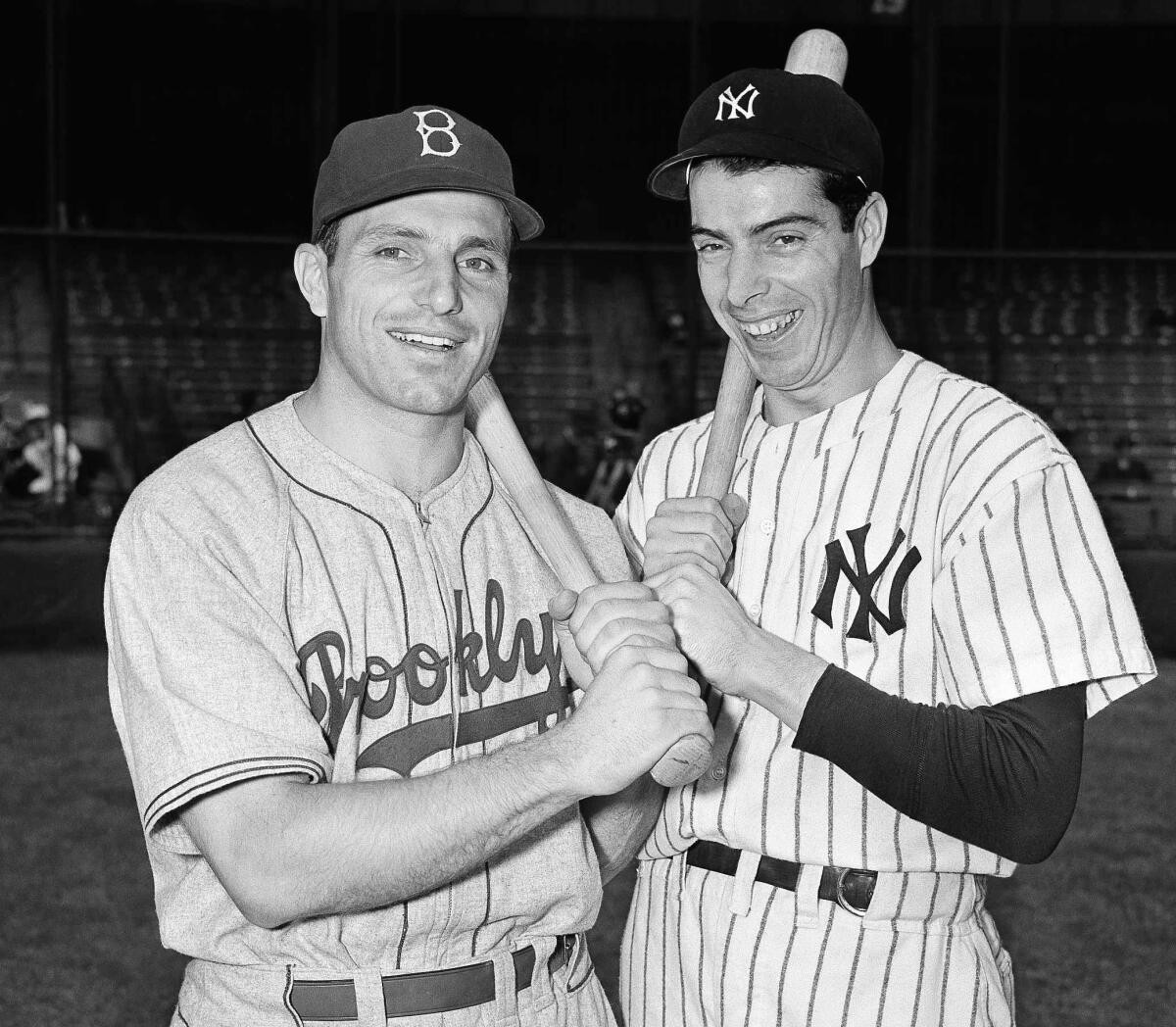
The inaugural World Series meeting between the Dodgers and Yankees in 1941 showcased Dodgers uniforms that, while recognizable, were notably different from today’s. Playing then as the Brooklyn Dodgers, their road uniforms featured “Brooklyn” in blue script across the chest. Both home and road jerseys were zipper-front, a detail distinguishing them from modern Dodgers uniforms. Their caps displayed a white “B” for Brooklyn on a royal blue base. The road uniforms included thin blue piping on the headspoon, double sleeve stripes, and piping down the pants and belt tunnels. The home uniform featured a “Dodgers” script, foreshadowing the iconic look of future Dodgers home uniforms.
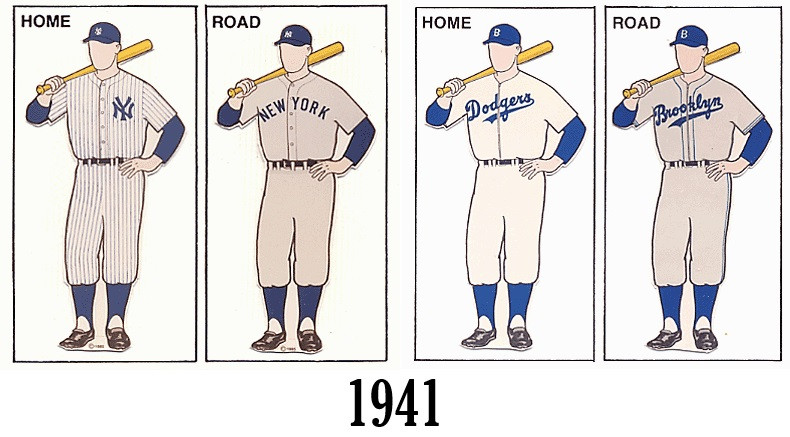
A side-by-side comparison of the 1941 Dodgers and Yankees World Series uniforms, highlighting the early Dodgers “Brooklyn” script and the classic Yankees pinstripes.
The Yankees uniforms of 1941 were already quite similar to their contemporary versions. However, the jerseys featured set-in sleeves, unlike today’s raglan sleeves, and the home pinstripes were slightly wider apart. Road uniforms simply read “NEW YORK” in an arched radial design. Both teams still used McAuliffe font for their numbers.
The Yankees emerged victorious in the 1941 World Series, winning four games to one.
1947
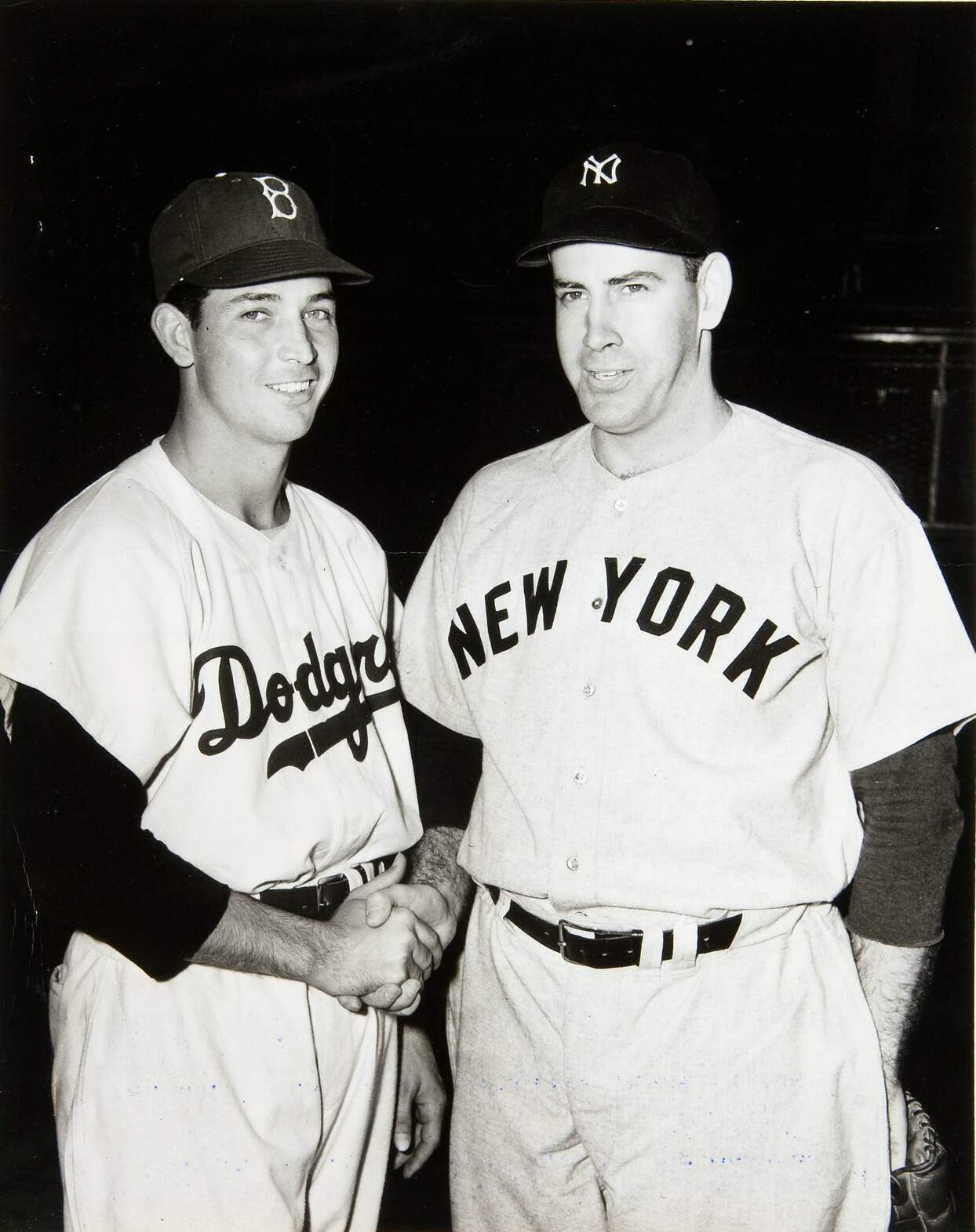
The 1947 series, following Jackie Robinson’s historic rookie season, saw both teams’ uniforms evolve closer to their modern counterparts. While still utilizing set-in sleeves, the Yankees uniforms by 1947 featured the same iconic “NY” chest logo that remains a staple today. The road uniforms were gray flannel with “NEW YORK” arched across the chest. The pinstripes on the home jerseys appeared slightly closer together than in 1941.

A close view of the 1947 Brooklyn Dodgers home jersey, showcasing the block numbers and the classic “Dodgers” script, precursors to modern Dodgers uniforms.
The Dodgers home and road uniforms remained largely consistent, though the home jerseys now featured block numbers. A significant change for Dodgers uniforms was the replacement of “Brooklyn” with “Dodgers” on the road gray jerseys, marking a step towards the unified team identity we know today.
The Yankees secured their second consecutive World Series title against the Dodgers in 1947, winning a tight series four games to three.
1949
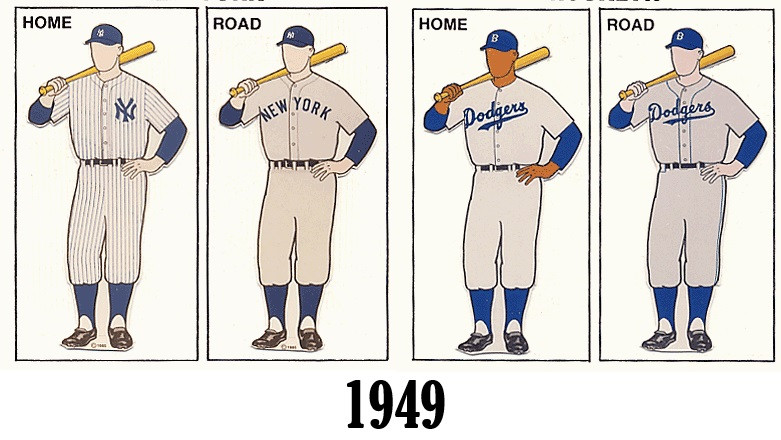
Just two years later, in 1949, the two teams met again, and the Dodgers uniforms were virtually unchanged from their 1947 appearance. Their commitment to classic design was already evident.
Similarly, the Yankees uniforms remained basically the same as in 1947, reinforcing their iconic and enduring style.
The Yankees had a more comfortable victory in 1949, defeating the Dodgers four games to one.
1952
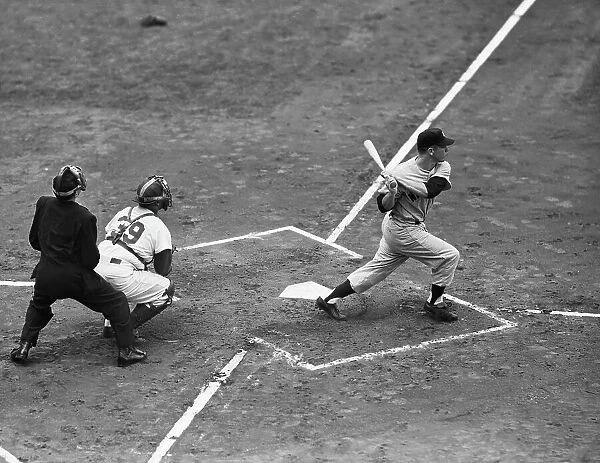
By the 1950s, both teams’ uniforms were approaching the designs almost identical to their current versions. The 1952 Brooklyn Dodgers made history as the first major league club to display uniform numbers on the front of their jerseys, a pioneering style adopted for their home uniforms. This innovation significantly altered the look of Dodgers home uniforms, while the road uniforms still featured piping and no front number. The rear number now appeared in block font.
Throughout the 1952 season, the Yankees sported a sleeve patch both at home and on the road, commemorating their 50th year. Aside from this patch, there were no major changes to the Yankees uniforms from the previous year, maintaining their timeless aesthetic.
This World Series again went the Yankees’ way, another hard-fought series that the Yankees won in seven games.
1953
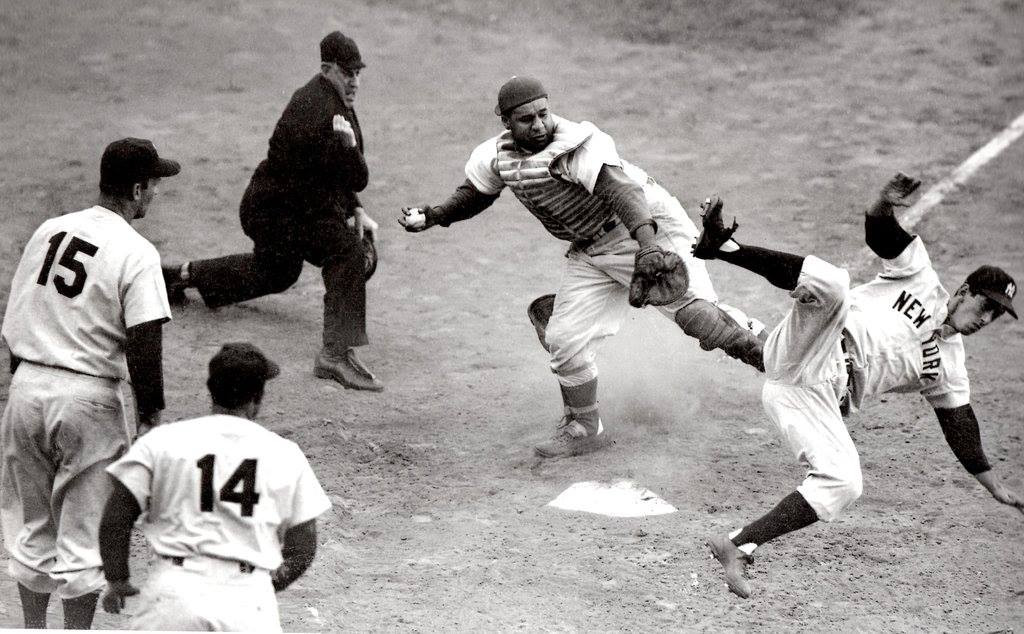
The very next year, 1953, saw another World Series clash between these teams. The uniforms remained largely unchanged from the previous season, except for the Yankees sleeves now being patch-free after their anniversary year. This series is also remembered for Mickey Mantle’s spectacular grand slam.
Mickey Mantle hitting a grand slam in the 1953 World Series, showcasing the classic Yankees home uniforms against the road Dodgers uniforms of the era.
The Dodgers once again fell short of their first World Series title, losing to the New York Yankees in six games, marking the Yankees’ fifth consecutive World Series win (1949-1953).
1955

After a year apart, the two teams met again in the epic 1955 World Series. This year finally belonged to the Dodgers. After five consecutive World Series losses to the Yankees, the Dodgers finally won their first, and only, World Series title in Brooklyn. Dodgers fans’ long-held slogan, “Wait till next year!”, transformed into “This IS next year!” after their historic win.
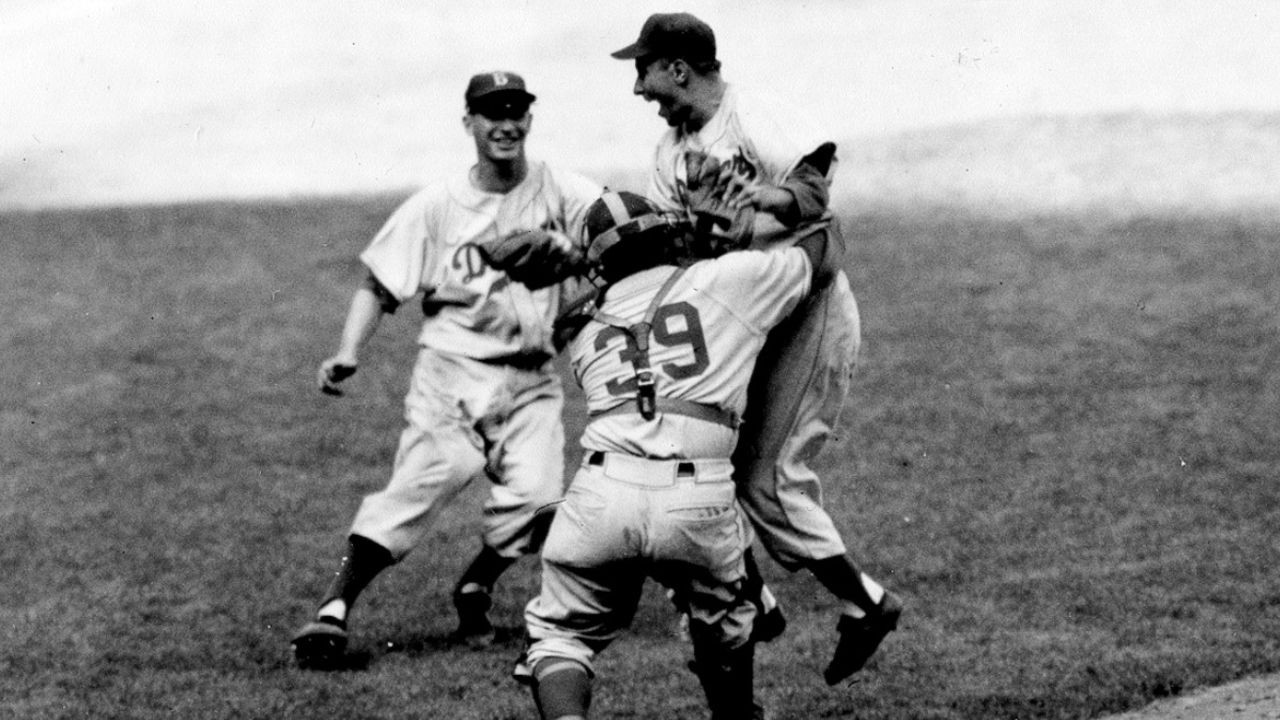
A celebratory moment from the 1955 World Series, highlighting the classic Dodgers home uniforms in their breakthrough championship year.
The uniforms for both teams remained essentially unchanged from their 1953 meeting, underscoring the timeless nature of these designs even during moments of significant team history.
The Dodgers triumphed over the Yankee dominance, winning the World Series in seven games, with Johnny Podres pitching a 2-0 shutout in the decisive Game 7.
1956
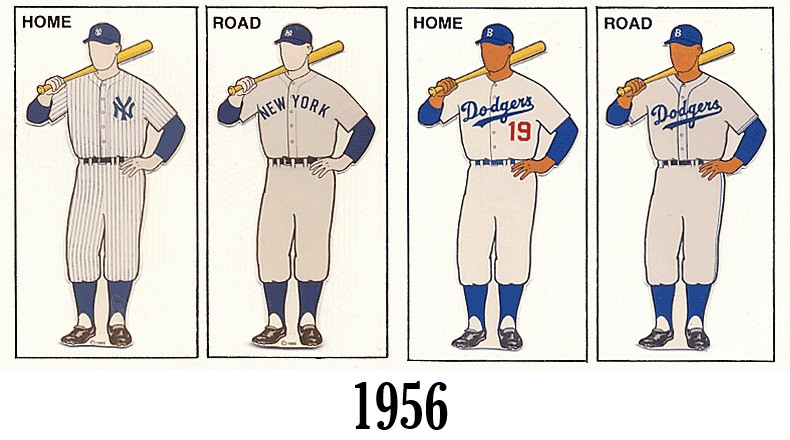
The 1956 World Series marked the final matchup between the Yankees and Brooklyn Dodgers. It was another thrilling series, extending to seven games. Intriguingly, in both the 1955 and 1956 World Series, the home team won the first six games, only to lose Game 7. The uniforms remained consistent with the previous year, maintaining the visual tradition. 1956 is particularly memorable as the year Don Larsen pitched the only perfect game in World Series history.
Despite a valiant effort, the Dodgers lost another seven-game series to the Yankees.
1963
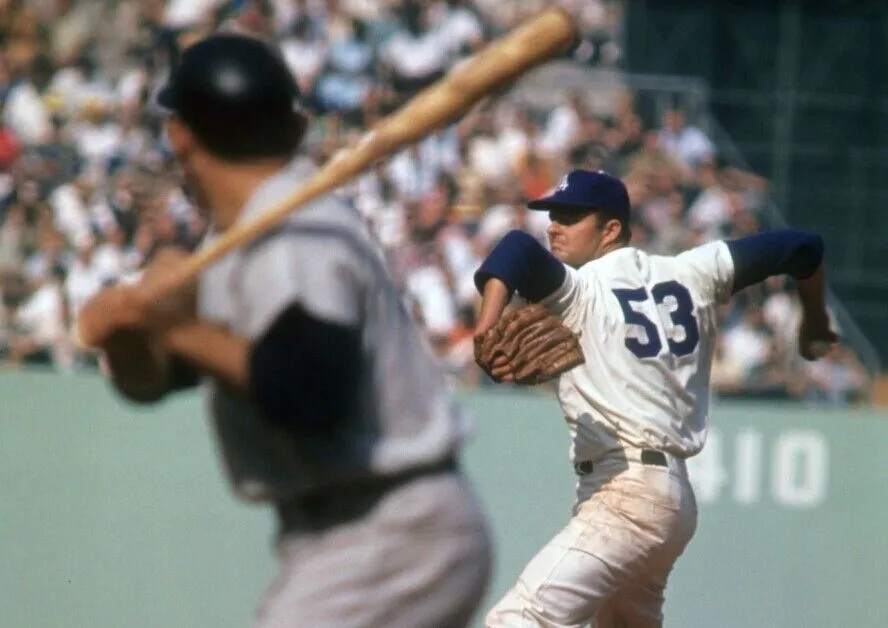
By 1963, the Yankees, while still a strong team, were beginning to decline, while the Dodgers were emerging as an NL powerhouse, now based in Los Angeles since 1958. The Yankees uniforms in 1963 were slightly more tailored, and their stirrups showed a bit more white, but fundamentally, they remained the same. In contrast, the 1963 Dodgers uniforms, reflecting their move to Los Angeles, incorporated several changes.
The Dodgers road uniforms now displayed “Los Angeles” in blue script, a significant update to Dodgers uniforms reflecting their new city. Red front numbers were also added to the road jerseys. Both home and road caps featured the iconic interlocking “LA” logo. 1963 was also the inaugural World Series played at Dodger Stadium.
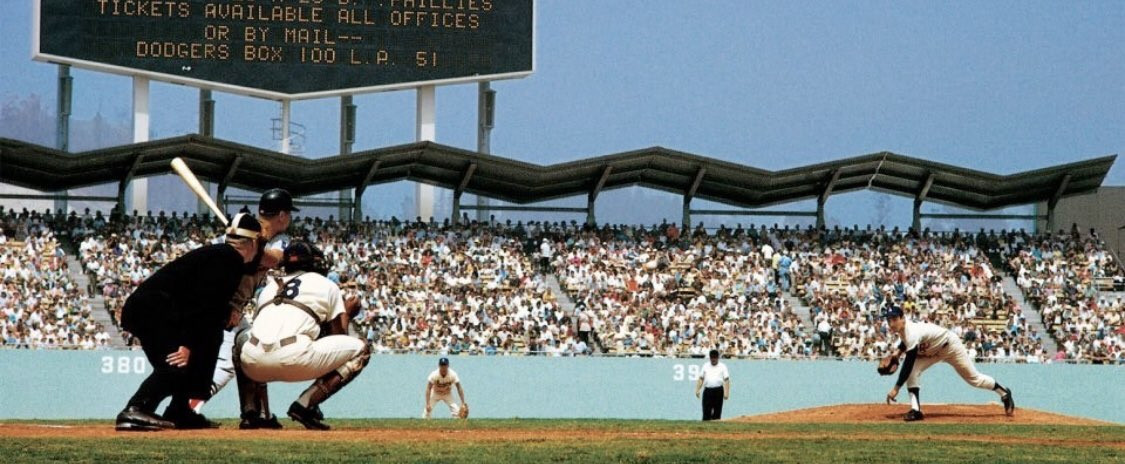
A dynamic shot from the 1963 World Series, showcasing the Dodgers road uniforms with the new “Los Angeles” script and red numbers, marking a transition in Dodgers uniform history.
Despite the changes to the road Dodgers uniforms, the home uniforms, aside from the new LA cap logo, remained largely unchanged, maintaining a link to their Brooklyn roots.
The Dodgers avenged their previous World Series losses to the Yankees, sweeping the 1963 World Series in four games.
1977
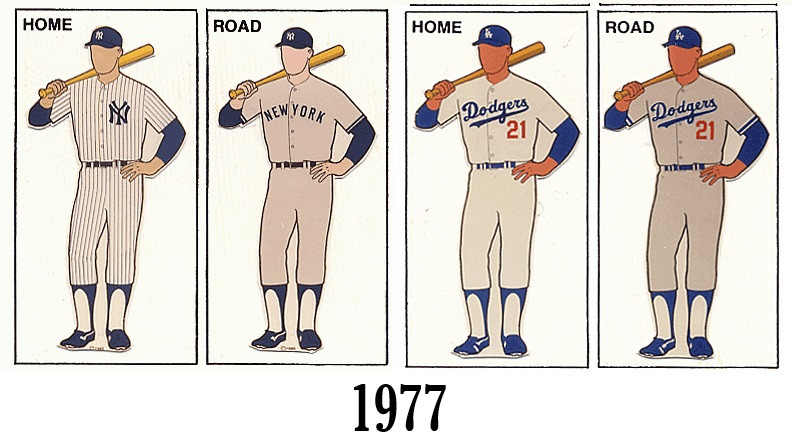
After eight World Series meetings in 22 years, the rivalry paused until 1977. By this time, MLB had transitioned from flannel to polyester uniforms, bringing changes to both teams’ looks. The Dodgers home uniforms still maintained their classic appearance, a testament to their enduring design. The most notable change was the addition of names on the back (NOB) to both home and road jerseys across MLB. The road jerseys featured white outlines around the NOB and numbers, along with a new “Dodgers” road script. Sleeves also included a white/blue/white stripe at the hems.
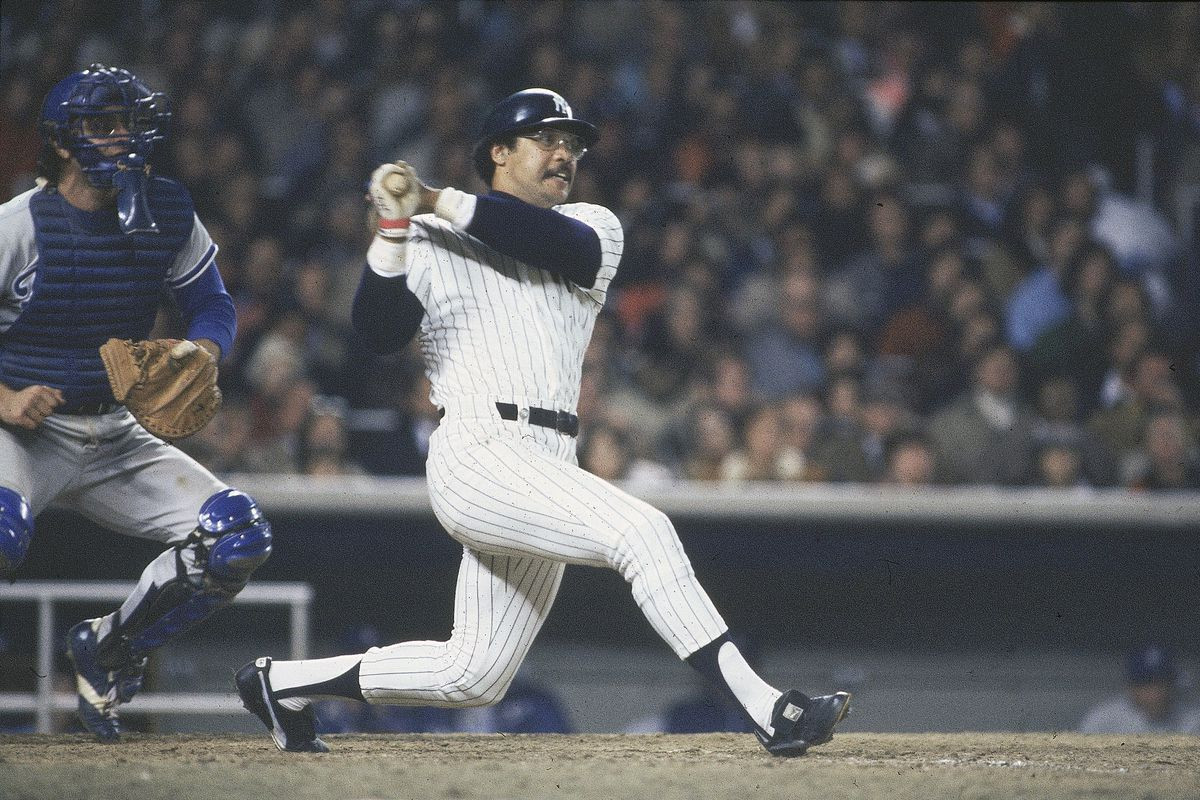
Reggie Jackson in the 1977 World Series, displaying the Yankees road uniforms with white outlines on the lettering and numbers, a subtle update to the classic design.
Like the Dodgers, the Yankees home uniforms remained virtually unchanged. Their road uniforms received similar treatment to the Dodgers, with white outlines added to the wordmark and rear numbers. Sleeve ends also featured a navy/white/navy stripe at the hem.
Game Six of the 1977 series became legendary, with Reggie Jackson hitting three home runs on three consecutive pitches, helping the Yankees secure the game and the series.
The Yankees won the 1977 World Series in six games, extending their World Series record against the Dodgers to 7-2.
1978
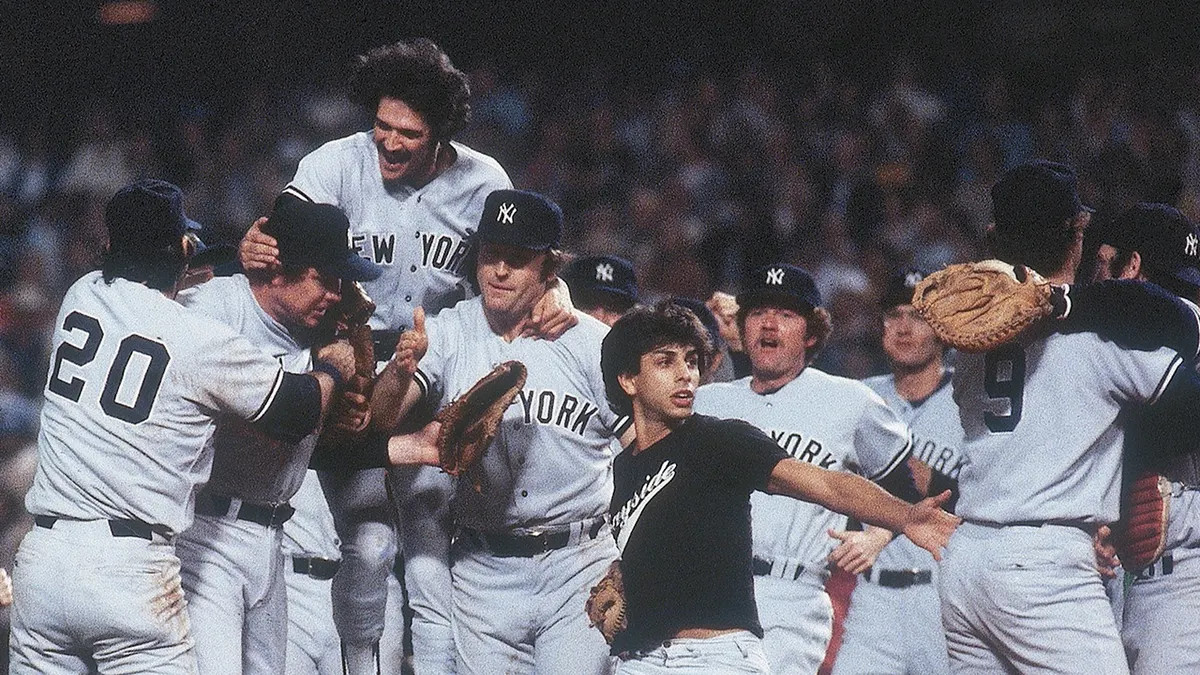
The Dodgers and Yankees rematched in 1978, but like the uniforms, which were unchanged from the previous year, the outcome remained the same. Similar to Reggie Jackson’s performance in 1977, Graig Nettles’ outstanding play at third base was a defining moment of the 1978 series.
The Yankees repeated as World Series Champions in 1978, winning again in six games. This marked the last World Series where the Yankees defeated the Dodgers, improving their head-to-head record to 8-2.
1981
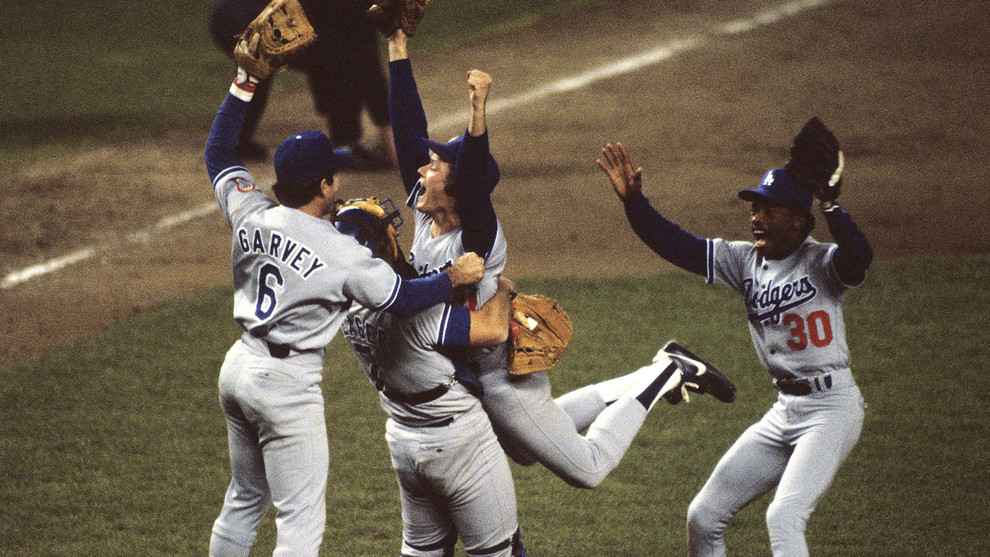
The 1981 World Series marked the last time the Yankees and Dodgers met in the Fall Classic before this year. This series mirrored the 1978 World Series in an interesting way: in both, the eventual losing team won the first two games, only to lose the next four. In 1978, the Yankees did this to the Dodgers, but in 1981, the Dodgers reversed the script, winning their third and final World Series against the Yankees.
1981 was the year of Mexican rookie sensation Fernando Valenzuela, who took the baseball world by storm. Valenzuela’s remarkable season and recent passing add an emotional layer to this year’s World Series as the Dodgers honor his memory.
The Dodgers uniforms in 1981 featured a special patch, the Los Angeles Bicentennial logo.
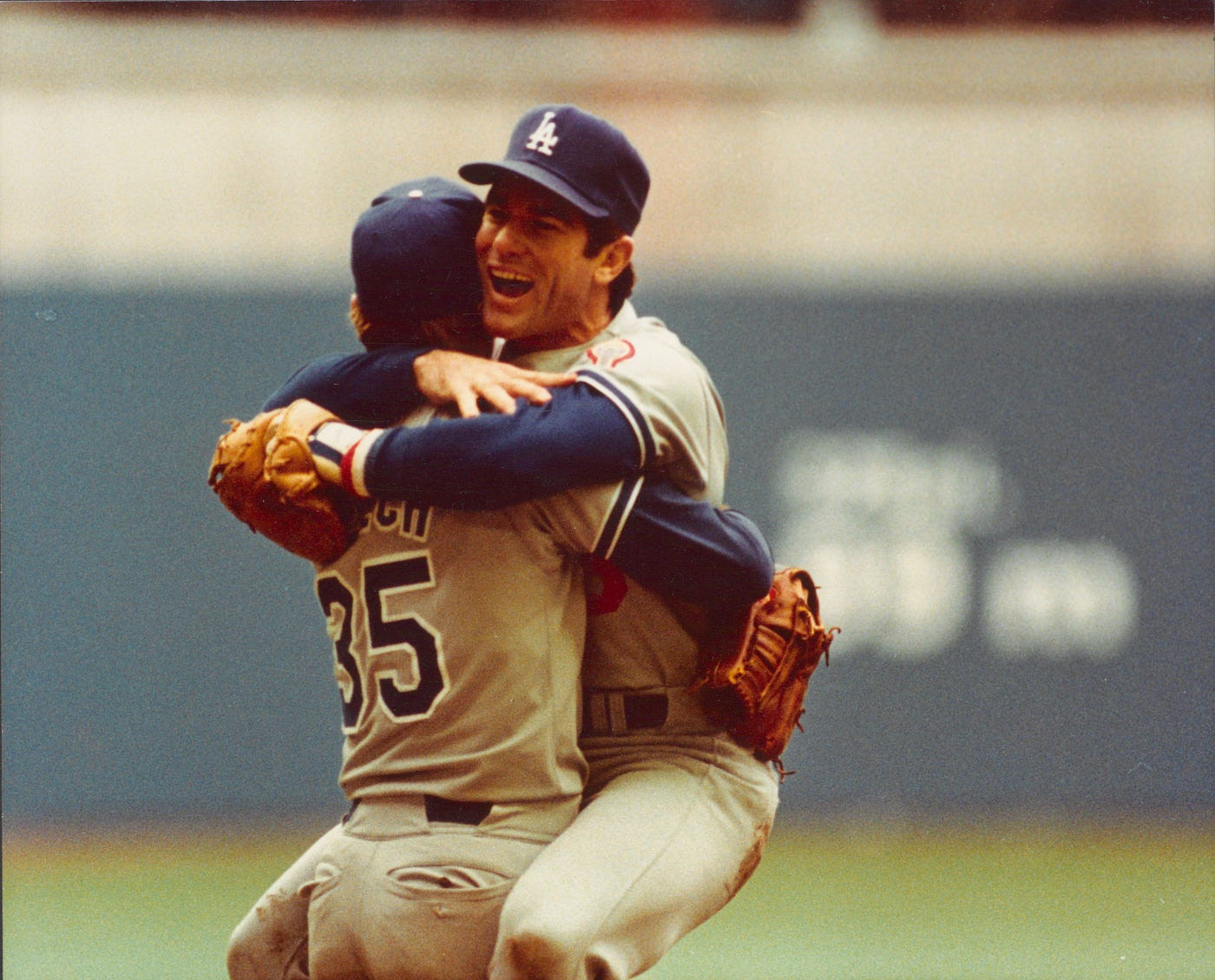
Celebration after the 1981 World Series, featuring the Dodgers road uniforms with the LA Bicentennial patch, marking their last World Series victory against the Yankees until potentially this year.
As noted, the Dodgers avenged their 1977-78 losses to the Yankees in 1981, securing their third title against the Bronx Bombers and solidifying a memorable chapter in Dodgers uniforms history.
Conclusion
This historical overview of the 11 World Series clashes between the Dodgers and Yankees highlights not only a compelling rivalry but also the remarkable consistency of their uniforms. Few teams across sports can boast such enduring and iconic visual identities. Even for those less invested in baseball, this World Series promises to be one of the most visually appealing in recent memory, thanks to the timeless Dodgers uniforms and Yankees uniforms. Despite modern advertising creeping onto jerseys and helmets, the core aesthetic of pinstripes versus Dodger blue remains a beautiful and classic representation of baseball at its highest level.
